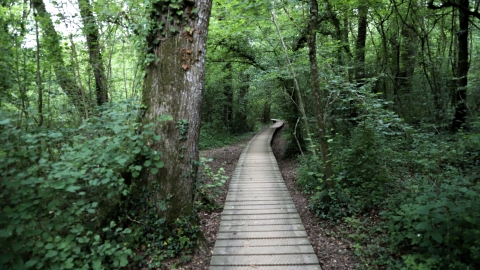
Langford Heathfield - Sophie Lauren
Langford Heathfield
Location
Know before you go
Dogs
Visit the 'Dog walking on reserves' page in the Contact section for more information.
When to visit
Opening times
Open at all timesBest time to visit
April to AugustAbout the reserve
Langford Heathfield, the Trust's second largest reserve, consists of heathland, scrub, secondary and ancient oak and ash woodland.
This is a wonderfully diverse woodland. The mixture of tree types, big grassy clearings and open rides cutting through the wood make this a great place for birds. Resident through out the year are Green and Great Spotted woodpeckers, Nuthatches, Tree Creepers, Marsh Tits, Long-tailed Tits, Blackcap and Mistle Thrush. The hard to spot Lesser Spotted Woodpecker also occurs. In summer Wood Warbler, and Pied Flycatcher may also visit to breed. Come early in the day and in spring to make the most of the birdsong as it echoes through the wood.
During summer butterflies, including the Silver Washed Fritillary, Speckled Wood, Marbled White and Comma can be seen flying along woodland rides and in clearings in the wood. This reserve also has a diverse moth population.
Make a visit in July when the grasslands are full of grasshoppers and crickets, which rise up in waves as you walk through the grass. Also at this time of the year bees and hoverflies buzz around in huge numbers visiting thistles and bramble blossom along the woodland edge. Few places have such big populations of insects and it is a revelation to see so many together. In particular look out for the large and distinctive Hornets which make this reserve their home.
Beneath the taller trees are dense thickets of Hazel, Elderberry, Spindle and Hawthorn which is good habitat for the Dormice that live in this woodland. There are Badger setts and Roe deer can be seen all year with their numbers increasing in the winter as they come down from the hills to the west. At dusk you may catch a glimpse of bats flying along woodland rides including the Common Pipistrelle, Serotine and the rare Lesser Horseshoe bat.
In summer, particularly on sunny days, Grass Snakes, Adders and Common Lizards can be seen in the open grassland and heath areas, but they are very sensitive to heavy footfalls so you need to tread lightly to have a chance of seeing them.
The open grassy glades in the reserve are full of flowers including Betony, Yellow Rattle, Greater Bird's-foot Trefoil, Common Spotted, Heath Spotted and Southern Marsh Orchids. Earlier in the year the woodlands are full of Bluebells and Sweet Woodruff.
Reserve conservation management - To ensure the survival and improvement of the wildlife habitat much management work is undertaken. The grasslands are temporarily enclosed with electric fencing in the summer and grazed with ponies and sheep and the bracken and scrub are controlled. The woodlands and mature scrub are managed by a combination of coppicing and thinning. This will ensure that the next generation of oak and ash standards can become established and provides a healthy shrub layer. The glades and paths are kept open by annual cutting and the cutting of blocks of bracken on a three year rotation.
In the northern part of the reserve is an extensive area of neutral marshy grassland characterised by Purple Moor-grass, Sweet Vernal-grass, Quaking Grass, Flea-sedge and Meadow Thistle. Other species here include Sneezewort, Petty Whin and Saw-wort. Langford Heathfield is the only location in Somerset where the nationally scarce Pale Dog- violet occurs. This type of neutral marshy grassland is now rare in Britain. An unusual feature of the vegetation in this area is the occasional presence of heathland plants typical of more acid conditions, such as Common Heather, Cross- leaved Heath and Western Gorse.
Although Somerset Wildlife Trust own the land, much of Langford Heathfield nature reserve is common land, where some local residents in particular properties, still have the ancient rights of pasturage (grazing), turbary (turf cutting) and estovers (woodcutting for fencing and firewood.)
Because the reserve is common land, and very damp, it has never been used for intensive agriculture, which results in many important wildlife species surviving here. Most of the reserve was purchased by the Trust in 1982 with Coram’s Wood and Lucas’s Copse added in 1985.
Langford Heathfield is close to Clatworthy Reservoir, Wimbleball Lake and National Trust Wellington Monument.
